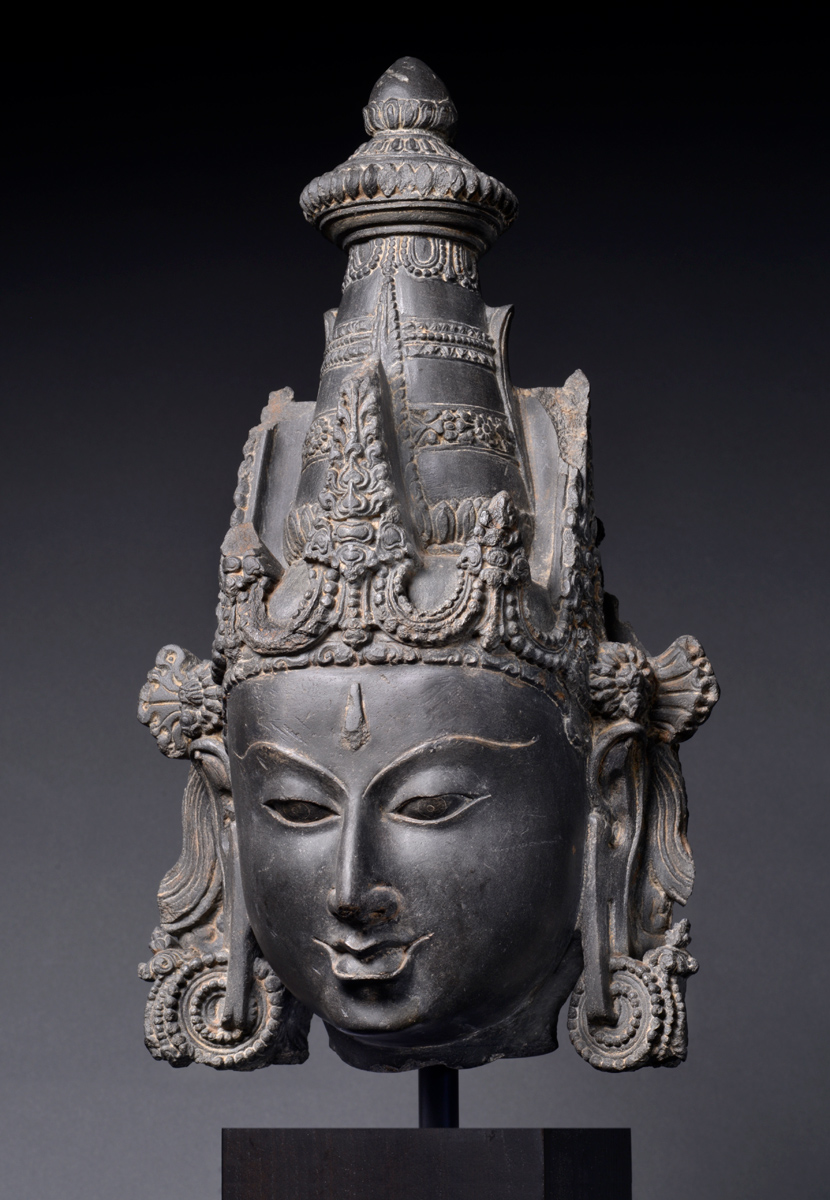

|
9. Head of Surya Eastern India Pala Dynasty 11th- 12th century Black basalt height 41 cm |

Like in many ancient cultures, the veneration of the sun in India goes back to remote times as the source of life-giving warmth and energy. In Vedic and post-Vedic literature he is the center of creation, to the point where the un-manifest becomes manifest. At the beginning of the 20th century, scholars of classical languages and cultures suggested that the representation of the Indian sun god showed elements from the Iranian solar god, mainly because of the Persian style boots he is wearing, like a warrior. There might be some truth in this since the original Indo-Aryans and Irano-Aryans had common roots and used very comparable languages and rituals. However, it is clear that Surya is deeply rooted and authentic in Indian culture. Many ancient, still existing Surya temples are dotted all over the country. The 8th century Surya temple of Martand in Jammu and Kashmir, the 11th century Sun Temple of Modhera in Gujarat and the 13th century Sun Temple of Konarak in Orissa are just a few of many famous examples. Also the Sena dynasty in northeastern India (11th -13th century) built sun temples like the Umaga Surya temple and the Surya Mandir in Bihar. For a long time Surya has been depicted in this region, according to the Pala styles from the mid- 8th to the early 13th century. The present head shows no explicit symbols or iconographical details. However, in comparison with other Pala style sculpture, in particular the distinct shape of the tall crown, the head is consistent with other images of the sun god Surya. This head of the god was most definitely part of a large stela with a decorated stone at the rear. It would have been full of details such as his denominating attributes, the two open lotus blossoms in his hands, his attendants Pingala and Danda, and his female consorts, probably even his charioteer, Aruna, with his seven horses riding through the sky. … But in this particular case, concentrating solely on the powerful head can be very revealing. Surya has a broad face, while the striking ridge of his eyebrows forms a flaming accolade leading to the bridge of a sharp nose with fine nostrils. The eyes have a well contoured almond shape, finely marked pupils and heavy eyelids. The little mouth with pronounced and finely marked lower lip shows a subtle smile. The urna on his forehead denotes divinity and spirituality. The long earlobes are embellished with two spiraling beaded earrings. His tall crown is remarkable. Its diadem portion is bejeweled with small garlands of pearls, and at the sides are open blossoms and streamers falling behind the ears. The central section of the crown is conical and surmounted by a finial that resembles an amalaka, the finial of a Hindu temple, with a lotus bud on top. Three sides of the tapering crown are decorated with triangular panels decked with flaming jewels. The glossy black sculpture radiates royal majesty and divine splendor, marking this imposing head of Surya as the Pala style at its zenith. Provenance: Private collection, USA, acquired in the 1970s. Rossi & Rossi Ltd., London, 2015. Private collection, Belgium, 2015-2019. Literature: S.L. Huntington, The “Pala-Sena” Schools of Sculpture, Leiden, 1984, ill.244. R. Ray & J. Van Alphen, Tejas: Eternal Energy, 1500 Years of Indian Art, Brussels, 2006, pp.212-217. J. Guy, Indian Temple Sculpture, Victoria & Albert Museum Publication, London, 2007, pp.150-153. Detail: close-up |